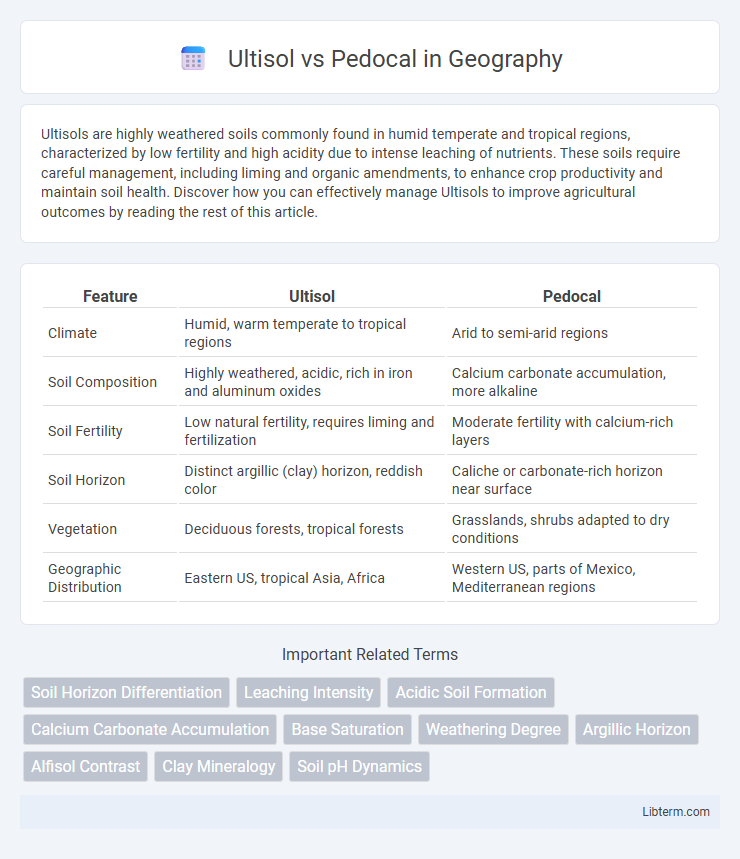Ultisols are highly weathered soils commonly found in humid temperate and tropical regions, characterized by low fertility and high acidity due to intense leaching of nutrients. These soils require careful management, including liming and organic amendments, to enhance crop productivity and maintain soil health. Discover how you can effectively manage Ultisols to improve agricultural outcomes by reading the rest of this article.
Table of Comparison
| Feature | Ultisol | Pedocal |
|---|---|---|
| Climate | Humid, warm temperate to tropical regions | Arid to semi-arid regions |
| Soil Composition | Highly weathered, acidic, rich in iron and aluminum oxides | Calcium carbonate accumulation, more alkaline |
| Soil Fertility | Low natural fertility, requires liming and fertilization | Moderate fertility with calcium-rich layers |
| Soil Horizon | Distinct argillic (clay) horizon, reddish color | Caliche or carbonate-rich horizon near surface |
| Vegetation | Deciduous forests, tropical forests | Grasslands, shrubs adapted to dry conditions |
| Geographic Distribution | Eastern US, tropical Asia, Africa | Western US, parts of Mexico, Mediterranean regions |
Introduction to Ultisol and Pedocal
Ultisols are highly weathered soils typically found in humid temperate and tropical regions, characterized by low fertility and a subsurface clay accumulation. Pedocals develop in arid and semi-arid environments, containing higher calcium carbonate concentrations and exhibiting distinct horizons rich in calcium carbonate deposits. The contrasting formation processes and climatic conditions distinctly influence their mineral composition, nutrient availability, and overall soil properties.
Formation Processes of Ultisol and Pedocal
Ultisols form primarily in humid temperate and tropical regions through intense chemical weathering and leaching, leading to the accumulation of iron and aluminum oxides in the subsurface horizon. Pedocals develop in arid and semi-arid climates where evaporation exceeds precipitation, causing calcium carbonate to accumulate in the upper soil horizons due to limited leaching. The contrasting soil formation processes result in Ultisols having acidic, nutrient-poor profiles with significant clay content, while Pedocals exhibit higher base saturation and calcium-rich horizons.
Geographic Distribution
Ultisols primarily develop in humid temperate and tropical regions, especially in the Southeastern United States, parts of South America, Africa, and Southeast Asia, where intense weathering and leaching occur. Pedocals are typically found in arid and semi-arid regions such as the western United States, parts of Mexico, and Central Asia, characterized by limited rainfall and calcium carbonate accumulation in the soil profile. The geographic distribution reflects climatic influences on soil formation, with Ultisols favoring wetter environments and Pedocals thriving in drier conditions.
Physical Characteristics
Ultisols exhibit a reddish or yellowish color due to iron oxide accumulation and have a clay-rich subsoil with low base saturation, making them acidic and nutrient-poor. Pedocals are typically light-colored soils with a high concentration of calcium carbonate in the subsoil, exhibiting a crumbly, loose texture. While Ultisols have poor drainage and high clay content, Pedocals show better drainage and a coarser, sandy to loamy texture.
Chemical Properties
Ultisols are characterized by acidic pH values, high aluminum saturation, and low base saturation due to extensive leaching in humid climates, resulting in low nutrient availability for plants. Pedocals exhibit a higher pH, often alkaline, with significant calcium carbonate accumulation and greater base saturation, reflecting limited leaching in semi-arid to arid environments. The contrasting chemical properties impact soil fertility and management strategies, with Ultisols requiring lime application to correct acidity and Pedocals needing nutrient supplements to address potential micronutrient deficiencies.
Fertility and Agricultural Implications
Ultisols exhibit low natural fertility due to intense leaching and high acidity, often requiring lime and fertilizers to support crop growth. Pedocals have higher nutrient availability and alkalinity, making them more suitable for agriculture without extensive soil amendments. The contrasting fertility levels influence crop selection and management practices, with Ultisols demanding more intensive soil management compared to the relatively fertile Pedocals.
Soil Management Practices
Ultisols require acid-tolerant crops and the application of lime to raise soil pH, enhancing nutrient availability and improving crop yields. Pedocals benefit from organic matter incorporation and irrigation management to prevent salinization and maintain soil structure. Effective soil management in both soil types emphasizes erosion control and nutrient cycling to sustain productivity.
Environmental Impact and Sustainability
Ultisols, characterized by acidic, nutrient-poor soils with high clay content, often require significant amendments for agriculture, leading to potential soil degradation and increased erosion risk. Pedocals, found in arid and semi-arid regions with higher calcium carbonate content, support diverse vegetation with less intensive management, promoting better soil stability and lower runoff. The environmental impact of Ultisols tends to be more severe due to chemical inputs and erosion, while Pedocals offer greater sustainability through natural fertility retention and reduced need for synthetic fertilizers.
Common Vegetation and Ecosystems
Ultisols support acidic-loving vegetation such as pine forests, oak, and hickory trees typical of humid temperate and tropical regions. Pedocals are commonly associated with grasslands and drought-tolerant shrubs found in semiarid and arid ecosystems, including prairies and desert scrublands. The nutrient-poor, highly leached Ultisols favor forest ecosystems, while the calcium-rich Pedocals promote xerophytic plants adapted to limited moisture availability.
Comparing Ultisol vs Pedocal: Key Differences
Ultisols are highly weathered, acidic soils rich in iron and aluminum oxides, typically found in humid temperate and tropical regions with significant leaching, whereas Pedocals are calcium-rich, alkaline soils common in arid and semi-arid climates with limited leaching. Ultisols have low base saturation and require liming for agriculture, while Pedocals possess high base saturation and naturally support alkaline-tolerant vegetation. The key difference lies in their mineral content and soil pH, influencing fertility and vegetation types.
Ultisol Infographic

 libterm.com
libterm.com